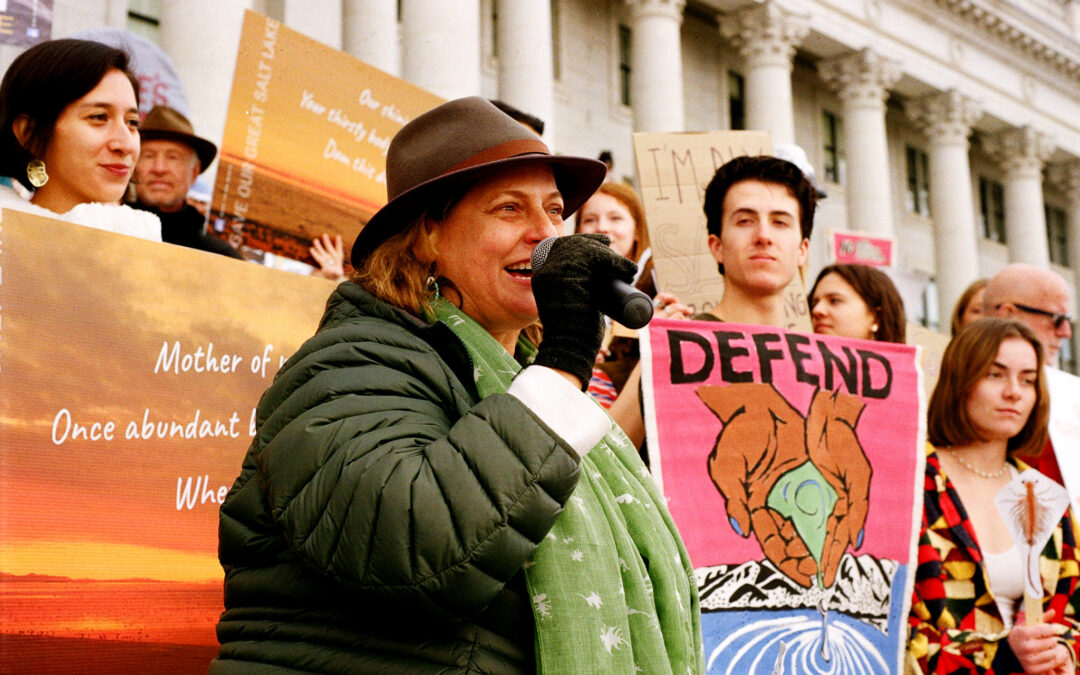Photo credits: Save Our Great Salt Lake
We had the opportunity to sit down with Nan Seymour from Save Our Great Salt Lake and River Writing and talk about her work with the Great Salt Lake Vigil. Lake-facing citizens hold this vigil twice a day through the Utah Legislative Session to show their love for and solidarity with the lake.
Who are you and how did you get involved with Great Salt Lake?
I’m a lake-facing poet who has been keeping vigil with Great Salt Lake for three years. This is the third legislative session vigil. The first two took place on Antelope Island, and they were more about being with the body of water directly at the shore. This year it felt important to bring the lake to the people and be right there at the Capitol during the session. We’ve been keeping a twice daily vigil that is art and movement driven.
How did the original vigil at Antelope Island come about?
As soon as I learned about the lake being in peril, I felt very focused. A lot of people didn’t realize that the center of our bioregion was in this serious condition, and it felt like a sudden diagnosis. You realize how much you care about somebody who was right there all the time, but you didn’t know that their life was at stake. I was in that state of kind of high alert, and I was writing a lot about it. I was dreaming about the lake a lot and really just trying to listen and pay attention. I felt like this was a direct invitation from the lake to come and be present. One of the reasons I think that this was not my idea is that I didn’t have a camper and I wasn’t a winter camper kind of person. I’m 57 and arthritic, and while I love being outside, I’m not some hardcore person. I don’t think I would have come to that on my own. So I feel like the lake invited me.
What do you see as the role of art in influencing policy and management decisions?
This is the kind of art that people make together in the village square. We get together to sing and dance–no one’s getting paid. Everyone is invited and you don’t have to be good at something already to participate. We have artists as young as three and people in their eighties helping. There’s just this range of possibilities. It’s that kind of art that builds community.
Does it impact policy? I don’t believe that it does directly. But I don’t think that makes it one bit less important. This kind of art and this kind of movement is coming in at a different frequency. It moves differently. Maybe it’s all the more important because it does move differently. What we are doing with this art is deliberately creating a lake-facing culture. Culture defines our values and values determine how we live. So somewhere in there, I would say values determine how we vote and how we live. Ultimately, we’re making the world we want to live in. The world we want to live in is lake-facing. It’s warm and connected. Everyone is invited.
Why do you think it’s so important to build a lake-facing community?
The term lake-facing is helpful because it describes how we’re oriented. We’re not forgetting where our center is and the art is a vehicle for that. The story that we tell, and I think it’s an accurate one, is that the lake is a creator, not a commodity. The lake is the center, not the periphery, and our lives are inseparable. We will organize around that story. We’ll create that story. And if we’re not telling that story, we will live a very different story. We have been living it, and it’s bringing us very close to our demise.
How have you seen community engagement change over the last three years?
It’s heartening because I see the movement growing exponentially. I see Grow the Flow as a big part of that because now we’re organizing around the most important things. In the past, we might have appeared disparate or even organized around our differences. Now we’re organized around what we hold most dear. The movement is exponentially bigger than it was three years ago when I first went to Antelope Island by myself. There were scientists at the lead who were already paying so much attention and I was so grateful to them. But it was a little bit lonely out there; you didn’t feel like there was a swell of people who care. Now you can look in any direction and find people who are increasingly willing to transcend tired divides.
We need scientists and policymakers as well as poets. The way I see the scientists in this movement is as barely disguised poets; it’s the same devotion and quality of attention that’s required. But at the end of the day, we need everybody. Sometimes people can feel like they don’t matter as much. Well, they all matter and it’s an all-hands-on-deck situation. If you are willing to carry a puppet, that’s not less important than making policy. It’s all necessary.
What have you learned from Great Salt Lake during your thirty days at the capital? And do you have anything else you’d like people to know about the vigil?
I feel like this is not just a lake-facing movement, but a lake-led movement. Great Salt Lake rises in support to meet any effort we make. Any effort I’ve personally made I’ve felt returned more than tenfold. I’m learning again that there’s no limit to what’s possible. We can live in reciprocity–maybe that’s the big lesson. We can meet the world with a loving and listening presence, and we can bring reciprocity.
As for the vigil, the really important thing to know is that everyone is invited. In the morning, it’s a silent walk with waves. We start at 8am at the southeast corner of the capitol grounds and it’s contemplative, reverent, and beautiful. In the evening, the vigil starts at 5pm and we move around the capitol the opposite way. It’s very jubilant–there’s singing and costumes. We’re celebrating the species. The vigil ends this Friday but these efforts won’t end. There will continue to be public calls of participation and I hope that anyone who is curious will follow their curiosity to one of these events.

